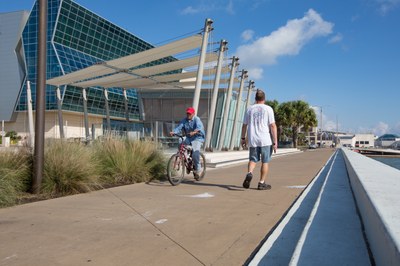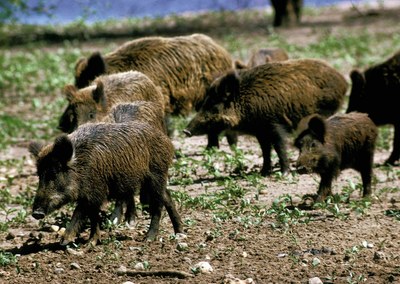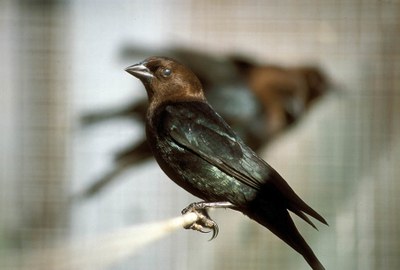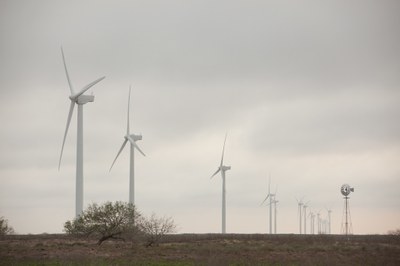Threat Reduction
 Glass Collisions
Glass Collisions
Light Pollution
Pesticides
Invasive & Harmful Species
Feral Hogs
Outdoor & Feral Cats
Brown-headed Cowbirds
European Starling
Wind Turbines
Plastic Pollution
Climate Change
Glass Collisions
Up to 1 billion birds die each year in the United States from collisions with glass. Since birds cannot see glass as a barrier or see habitat reflected in it, many accidentally strike glass while they try to navigate around houses, office buildings, and barrier structures. Luckily, window strikes and glass collisions can be minimized if homeowners, architects, and developers install easy-to-use and maintain products for decreasing glass collisions.
- Glass Collisions: An End to Birds Dying at Windows
- Stop Birds Hitting Windows
- Creating Bird-Friendly Communities: Lights Out and Reflective Surfaces
Light Pollution
In many urban areas, light pollution is becoming a major problem. Bright, artificial lights used throughout the night become disorienting for many wildlife species, including birds. These lights can often confuse migrating species, throwing them off of their migration path, often causing them to collide with buildings or die from exhaustion. By addressing this issue through smarter lighting solutions and attempting to reduce light pollution in urban areas, home owners and business owners/managers alike will not only help bird species but will reduce energy consumption as well.
Programs to reduce light pollution in your city:
- Creating Bird-Friendly Communities: Lights Out
- International Dark-Sky Association
- McDonald Observatory
Pesticides
Birds are extremely susceptible to the toxic chemicals and pesticides found in many home, garden, and agricultural products. Rat poisons like warfarin, neonicotinoid insecticides, and herbicides such as glyphosate are just some of the common pesticides that kill birds on a regular basis, either directly or indirectly through consumption. Avoiding these pesticides, searching for safer integrated pest management alternatives, and fighting for stronger regulations on the use of these harmful products can all make progress towards reducing this threat for native bird species.
Discover more information on how your community can protect birds from pesticides.
Invasive & Harmful Species
Invasive species, such as the red imported fire ant, feral hogs, European Starling, and House Sparrow all pose major threats to native bird species. Fire ants and feral hogs specifically affect many ground-nesting bird species, while European Starlings target cavity nesting birds. One of the major threats to many songbird species is death by feral or outdoor cats. Proper management of these invasive and harmful species will benefit native bird populations.
Feral Hogs
Feral hogs have spread throughout most of the state of Texas, with a current estimate of over 1.5 million hogs. As hogs forage for food by rooting and trampling, they cause significant damage to habitat. They can destabilize wetland areas, springs, and creeks from excessive rooting and wallowing, and often destroy and consume eggs of ground nesting birds, such as turkey and quail. Hunting and trapping are two common methods for dealing with this nuisance invasive.
- Texas AgriLife Extension: Feral Hogs
- TPWD Feral Hog Information
- Feral Hogs Impact Ground-nesting Birds
Outdoor & Feral Cats
It is estimated that feral and free-roaming cats kill roughly 2.4 billion birds every year. These non-native invasive animals significantly disrupt ecosystems, threaten birds and other wildlife, such as lizards, frogs, and snakes, and spread diseases. To reduce this threat, and for their own wellbeing and safety, domestic cats should be kept indoors. The formation of feral cat colonies should be discouraged, and Trap, Neuter, Release (TNR) programs should not be considered a long-term viable option for the maintenance of feral cat colonies.
Read more about the threats cats pose to birds, as well as the Cats Indoors Program below:
- Cats Indoors Information from American Bird Conservancy
- American Bird Conservancy: Trap Neuter Release
- Indoor Cats vs. Outdoor Cats Facts
- TPWD: Cat's Inside
- TPWD Issue Paper: Management of Feral Cat Colonies and Trap, Neuter, and Release (TNR) Programs
Brown-headed Cowbirds
Brown-headed Cowbirds are brood parasites, or birds that lay their eggs in the nests of other birds. These “host” birds incubate, feed, and raise the young of the Brown-headed Cowbird, who often out-compete the native songbird chicks it shares its nest with. Consequently, this is contributing to the decline in songbird populations throughout the state. They particularly affect at-risk species, such as the Black-capped Vireo.
Information on how to trap and remove brown-headed cowbirds from your area:
European Starling
These iridescent invasive birds have been extremely successful in their spread across the U.S. since their introduction from Europe in the 1890s. They compete with other cavity nesting birds, such as bluebirds, woodpeckers, and Purple Martins. These fierce birds will overtake nests and negatively affect native bird populations. See how to minimize their effects here:
Wind Turbines
Wind turbines used to generate wind energy are projected to kill over 1.4 million birds annually by 2030. This expanding technology poses a risk to many raptor species, like the Golden Eagle, as well as threatened and endangered species, such as the California Condor and Whooping Crane. Many bird species are also negatively impacted by the habitat destruction necessary to build wind farms.
For more information on how to address this issue in your community, follow these links:
- American Bird Conservancy: Wind Energy Challenges
- American Bird Conservancy: Wind Energy and Birds - Bird-Smart Strategies
Plastic Pollution
Our choices, both as individuals and communities, create a large impact. Single-use plastics (straws, balloons, shopping bags, etc.) are so ubiquitous, we often forget how their short-lived life can permanently change the lives of wildlife, especially our coastal birds. Even when our communities are not based on the coast, the way plastics can travel large distances highlights how our choices to live with less single-use could have a positive, wide-reaching impact.
Articles and How-to links:
- Microfilament Recycling Tubes
- Single-use Plastics
- Balloons Blow
- Balloon Release Impact article
- UN Environment
Climate Change
As the climate of our planet changes, so too do the resources, habitats, and ranges of many bird species. It is vital that communities actively protect at-risk species in their area, as these species may also be more susceptible to climate change. As ranges shift and shrink from their historical boundaries, as storms continue to disrupt populations, as migratory patterns begin to vary, conservation leaders in Bird City Texas communities should aim to mitigate the effects of this threat on local and migratory bird populations.
For more information on how climate change may affect bird populations, click here: